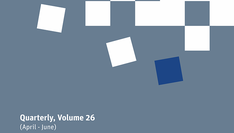Abstrakt
This research aimed to find facts on weaknesses and constraints that occurred in the field, and tried to prepare an alternative strategy model for supervising and empowering batik business to boost Purworejo’s community economic welfare. The research was held in a number of sub-regions which it was known as batik culture area in the past time. This research applied qualitative methods to obtain in-depth illustration on real situation and condition in the field. The result concluded that to develop and to empower Purworejo’s Batik, it was needed an alternative strategy, which included the comprehensive planning and supervising on batik industries in Purworejo. Batik craftsmen and business players were necessary to be empowered on business location, physical equipment, supporting goods, raw materials, products design, energy, manpower and time. Beside from the Government side, it was necessary such a strong political willingness on general policy and specially that aim for empowering and increase batik industry to become master in its own country.
Bibliografia
Alma, B. (2010). Kewirausahaan. Bandung: Alfabeta.
Cooper, D. R., Schindler, P. S. (2000). Business Research Methods. 7th (Seven). Toronto: McGraw-Hill.
Day, G. S. (1999). Market Driven Strategy: Processes for Creating Value. New York: Free Press.
Denzin, N. K. and Lincoln, Y. S. (2009). Handbook of Qualitative Research. Yogyakarta: Pustaka Pelajar.
Goldstein, B. (2007). The Ultimate Small Business Marketing Toolkit: All the Tips, Forms, and Strategies You’ll Ever Need. 1st editio. Toronto: McGraw-Hill.
Griffin, R. W., Ebert, R. J. (2004). Business. Seventh Ed. New Jersey: Prentice-Hall, Pearson Education International.
Hastuti, T. D. and Sihombing, R. P. (2020). Analysis of Entrepreneurial Development of Natural Coloring Batik: A Case Study in Central Java Indonesia. "Journal of Business and Finance in Emerging Market", 2(2).
Hengky, S. (2018). Batik-Craft Tourism’s Competitiveness in Madura, Indonesia. "Journal of Management Research", 10(4). DOI: 10.5296/jmr.v10i4.13623.
Levy, M., Weitz, B. A. and Grewal, D. (2001). Retailing Management. Internatio. Toronto: McGrawHill Irwin.
Longenecker, J. G., Moore, C. W. and Petty, J. W. (1994). Small Business Management: An Entrepreneurial Emphasis. 12th editi. Ohio: South-Western College Pub.
Lubis, H., Rohmatillah, N., Rahmatina, D. (2020). Strategy of Tourism Village Development based on Local Wisdom. "Jurnal Ilmu Sosial dan Humaniora". DOI: 10.23887/jish-undiksha.v9i2.22385.
Moleong, L. J. (2017). Metodologi Penelitian Kualitatif (Edisi Revisi) [in:] PT. Remaja Rosda Karya.
Mulyani, N. S. et al. (2019). Implementation of Cultural Heritage in the Development of the Batik Industry in Ngawi Regency. "Universitas Sebelas Maret Repository".
Nitisusastro, M. (2010) Kewirausahaan & Manajemen Usaha Kecil. Bandung: Alfabeta.
Pudjowati, J. et al. (2019). The Influence of Business Network and SME Empowerment Towards Business Sustainability (Study of Handmade Mangrove Batik SME Surabaya). "Journal of Engineering and Applied Sciences". DOI: 10.36478/jeasci.2019.6625.6633.
Ricklefs, M. C. (2005). Sejarah Indonesia Modern 1200–2004. Jakarta: Serambi Ilmu Semesta.
Sari, S. R. et al. (2020). Value Chain Analysis on Handmade Batik Products. JEJAK. DOI: 10.15294/jejak.v13i1.21771.
Sigit, S. (2003). Pengantar Metodologi Penelitian Sosial-Bisnis Manajemen. Cetakan Ke. Yogyakarta: Penerbit Bagian Penerbitan Fakultas Ekonomi Universitas Sarjanawiyata Tamansiswa.
Siropolis, N. C. (1994). Small Business Management: A Guide to Entrepreneurship. 5th editio. Boston: Houghton Mifflin Co.
Sudja, W. A. (1979). Proses Pembuatan dan Pewarnaan Batik di Indonesia. Bandung: PT Karya Nusantara.
Sugiyono (2009). Metode Penelitian Kuantitatif, Kualitatif dan R&D. Bandung: Alfabeta.
Sugiyono (2016). Memahami Penelitian Kualitatif. Bandung: Alfabeta.
Suparno, S. et al. (2019). The Determinant Factors of Development Batik Cluster Business: Lesson From Pekalongan, Indonesia. "The Journal of Asian Finance, Economics and Business, 6(4). DOI: 10.13106/jafeb.2019.vol6.no4.227.
Suryani, I. E., Anggraeni, L. and Suryadi, U. (2015). Strategy Formulation for Developing Batik Tulis. "Indonesian Journal of Business and Entrepreneurship", 1(1). DOI: 10.17358/IJBE.1.1.23.
Widiana, M. E. et al. (2020). The Improving of the Quality Resources of Gedog Batik Craftsmen in Tuban Regency. "Indonesian Journal of Cultural and Community Development", 7. DOI: 10.21070/ijccd2020683.
Za, R. et al. (2019). Innovation and Marketing Strategy for Batik Products In The Industrial Age 4.0. "International Journal of Recent Technology and Engineering", 8(2S9). DOI 10.35940/ijrte.B1116.0982S919.
Wszystkie teksty zamieszczone w kwartalniku "Modern Management Review", dostępne są w pełnej wersji na stronie internetowej Czasopisma. Od numeru 19 (3/2012) zostały także wprowadzone identyfikatory cyfrowe (DOI: 10.7862/rz.2018.mmr.1)
Artykuły w czasopiśmie Modern Management Review są udostępniane na warunkach licencji Creative Commons (CC-BY 4.0), w tym na następujących polach eksploatacji obejmujących:
- prawo do wydawania Utworu drukiem w formie książkowej i cyfrowej oraz jego rozpowszechniania w formie książkowej i cyfrowej, w tym poprzez wyświetlanie, odtworzenie, nadawanie, publiczne udostępnienie przez Wydawcę oraz podmioty trzecie,
- prawo do utrwalenia i zwielokrotnienia całości lub części Utworu na papierze i w formie zapisu cyfrowego oraz w każdy inny możliwy sposób przez Wydawcę,
- prawo do wprowadzania Utworu do pamięci komputera oraz zapisywania Utworu w systemach informatycznych Wydawcy i innych podmiotów dystrybuujących treści cyfrowe,
- prawo do archiwizowania Utworu oraz tworzenia kopii Utworu na nośnikach elektronicznych przez Wydawcę, bez ograniczeń ilościowych,
- prawo do digitalizacji Utworu oraz dokonywania konwersji/przekształceń Utworu w wersji elektronicznej na inne formaty cyfrowe przez Wydawcę oraz podmioty trzecie,
- prawo do rozpowszechniania Utworu, w tym za pośrednictwem sieci Internet lub innych sieci teleinformatycznych przez Wydawcę oraz inne podmioty trzecie, w sposób umożliwiający oglądanie, czytanie, kopiowanie treści Utworu w postaci elektronicznej, tj. wszystkich elementów do niego należących, przy czym przez kopiowanie rozumie się zapisanie przez osobę zainteresowaną udostępnionego jej Utworu na wybranym przez nią nośniku,
- prawo do przechowywania Utworu w bazie danych Wydawcy i innych podmiotów dystrybuujących Utwór w jakiejkolwiek postaci, jak również jego przetwarzania w bazie danych Wydawcy oraz podmiotów trzecich,
- prawo do tłumaczenia i wydania Utworu w jednym z języków nowożytnych w jakiejkolwiek postaci przez Wydawcę oraz podmioty trzecie.


